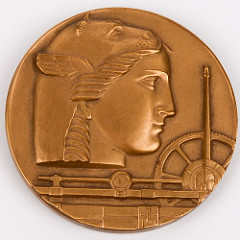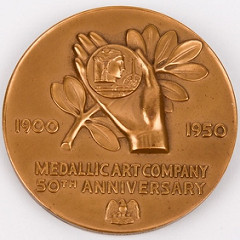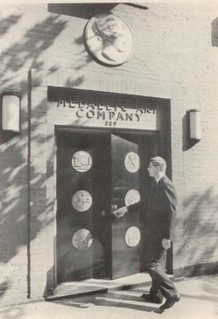
PREV ARTICLE
NEXT ARTICLE
FULL ISSUE
MEDALLIC ART COMPANY 50TH ANNIVERSARY MEDALLast week I published an auction lot description for a Medallic Art Company medal. Dick Johnson submitted this background on the medal, and the story of his employment at the
company. Thanks! -Editor
  Medallic Art Company 50th Anniversary Medal The Medallic Art Company 50th Anniversary Medal mentioned in last week’s E-Sylum requires comment. First, the machine on the obverse is not a “coin press,” but is the upper portion of the Janvier die-engraving pantograph, the machine on which the firm was founded and was instrumental in the production of most all their medals of the 20th century. Second, the history of the medal is just as fascinating as the design itself. Clyde C. Trees owned Medallic Art Co. since 1927 when he had purchased it from the Weil brothers, who had operated it for two and a half decades before. He struggled to keep the firm alive during the depression of the 1930s when he kept the staff working only half days, and during the war years when he could not obtain bronze to strike medals because it was needed for war armaments. Following the war, however, business changed dramatically, The U.S. government required military decorations, by the millions. In addition to campaign medals, medals of honor, it required medals of victory. It produced the “Ruptured Duck” – the eagle pins for veterans. It also produced the American Campaign Medal. When I was cataloging the firm’s medals I saw one purchase order from the Quartermaster Corps for a quarter million Victory Medals. Trees made considerable profits from these government orders. He bought real estate with these profits, buying a home in White Plains and two tiny adjacent parcels of land on the east side of Manhattan. It was an industrial area at the time, the city’s meat packing plant was located a half block away. Later Rockefeller, who owned much of that land donated it for the headquarters buildings of the United Nations. The area became far more genteel after that. The two tiny parcels of land were to be the plant for Medallic Art Company in midtown Manhattan. The existing buildings were not on the same level causing the first floor to have a slight ramp from one level to the other. He bought the land in 1948 and took two years to refurbish the buildings, install manufacturing equipment on the bi-level first floor, and build offices on the second floor. To celebrate the opening of this plant he obviously wanted to issue a medal. To add more importance to the medal, Trees decided to call it a 50th Anniversary Medal. He stretched the truth a little. The company name was not chosen until 1910, the first medal was made in 1908, the Janvier pantograph was not imported from France until 1902. The best event for a 50th anniversary he wanted to celebrate would have to be in 1900. As company historian the best I can imagine would have been the year Henri Weil, considered a founder of the firm, first went to work for a predecessor company, the Deitsch Brothers. That, however, cannot be documented. So Trees took a little artistic license here with the firm’s founding date. That’s a bit of irony, as a large part of their business later was issuing anniversary medals for other businesses. To make his anniversary medal even more important Trees launched a contest among sculptor-medallists to design the medal. He offered substantial cash prizes for the three best designs. He was inundated with 150 drawings and plaster models. A jury of sculptor peers chose not three, but four winning designs. First place winner was the medal you see here. It’s creator was Bruno Mankowski, who was paid $1,500 for the top design But that is not the end of the story; ten years later, in 1960, when William Trees Louth, Clyde Trees' nephew, president after Trees death, adopted the $250 fourth prize design, by Albert Wein, as the firm’s 60th Anniversary Medal. But that is still not the end of the story. In 1967 Louth pulled the plaster models of the second and third place winning designs, which the firm owned, out of the archives and issued these as coin club award medals. This included Adolph Block’s Eagle Medal and Patrick Whitaker’s The Die is Struck Medal with a hammer and anvil design.
As a college student in St. Louis I was president of the Missouri Numismatic Society, the local coin club. Because of this I was named a director of Central States Numismatic Society. In this capacity I purposed the regional Society replace their ugly logo of a map of the states the Society employed with a more artistic design. I wrote to Medallic Art asking if they could suggest such a logo change. I received a reply from president Louth along with a fantastic drawing of a paddle wheel river boat design – somewhat of a symbol of all the states covered. I met with Bill Louth on a trip to Kansas City, where he was visiting his wife’s parents. Presenting this drawing at the next directors meeting proved fruitless. It was tabled, the drawing assigned to the depths of the Society’s archives, never to be seen again. After college my employment progressed from a printing company in Dayton, a magazine editor in Houston, to the advertising department of my hometown newspaper in Kansas City, to Sidney, Ohio to create Coin World. Bill Louth followed my career along the way. In 1966 he was chosen to be the banquet speaker at the ANA Chicago convention. He asked me for ideas for his speech. I submitted six, he chose three and asked if I would write his speech. I did. That was in August. In October he asked if I would like to work for Medallic Art to replace the researcher in their sales department who had died. I was a coin collector with little knowledge of medals. “Didn’t matter,” he said they would train me, so I readily accepted. Moved the family and a sizable library to White Plains. In a small company you must wear several hats. My chores included researching sales leads for four salesmen as well as for the upcoming American Bicentennial, writing speeches for Bill Louth, creating press releases for the firm’s products, creating the firm’s advertisements, others, plus a major one of Bill’s greatest desire -- catalog all the past issues the company had produced since its beginning. I did get training in medallic art, from art director Julius Lauth. Everyone in the company answered my enquiring questions, it was better than a college course. I was with the firm for a decade. Did a lot of work for the Bicentennial and catalogued 6,127 medals. To read the earlier E-Sylum article, see: Wayne Homren, Editor The Numismatic Bibliomania Society is a non-profit organization promoting numismatic literature. See our web site at coinbooks.org. To submit items for publication in The E-Sylum, write to the Editor at this address: whomren@gmail.com To subscribe go to: https://my.binhost.com/lists/listinfo/esylum All Rights Reserved. NBS Home Page Contact the NBS webmaster 
|
